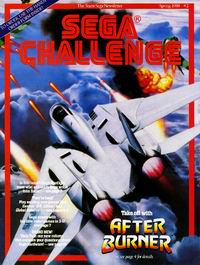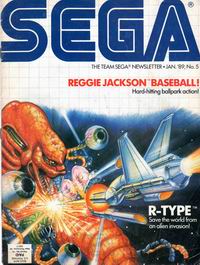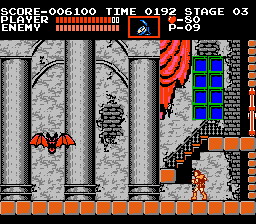
Back when I was about 7 or so, I took the finest double spaced paper from my penmanship class, stole a stamp from my parents, and wrote a letter, in pencil, to Sega of America, telling them they should have a newsletter like the Nintendo Fun Club. (I didn't own an NES back then, but my dad was a mail carrier, and he used to bring home any issues which were undeliverable.) A few weeks later, I got a typed letter thanking me for my enthusiasm, along with stack of about 20 pages of paper detailing hints and cheats for every game on the system, as well as an issue of Sega Challenge.
Sega Challenge was pretty much what I had asked for. It was just like the Nintendo Fun Club, in that it was very short and more of a promotional brochure than a magazine, but it was exciting nonetheless. After all, this was around 1988 or so - I'm not sure of Electronic Gaming Monthly or Video Games & Computer Entertainment had started yet, so getting any kind of information about video gaming was fairly precious.
Well, my old copies got thrown in the trash years and years ago, but the awesome folks at Zap! Online have been scanning them for your enjoyment. It's pretty amazing looking back on these. I actually had my parents order me a Sega Challenge t-shirt way back when, and I MAY have had a Sega beach towel (or I desperately wanted one, I can't remember.) I also got my copy of Power Strike through them, which wasn't officially released in retail stores at the time. (I think some copies bled through from Canada or something a few years later - I'm bit a sketchy on the details.)

They also sold these promotional tapes that were about half an hour long each, and had recordings of about a dozen Sega products. Which, again, were amazing, considering I only had one friend with a Master System, and there was no place to rent games, so it was a fine way to check out a game without dumping $50+ (three months of allowance!) on one. I still have these in my closet - I've thought about recording them, although the HG101 Digital Archive Project has come to a standstill due to Fileplanet deleting some of my files, and my computer's inability to transfer stuff to Megaupload.
Anyway, Sega Challenge soon became the Team Sega Newsletter after a few issues, then eventually became Sega Visions, which was a bit more of proper magazines like Nintendo Power, complete with reviews and such, although it was obviously still biased. It was still free for awhile, then they started charging for subscriptions, at which point I had dropped it. Still, this is a great look at Master System history!
This all came up regarding a not-yet-posted article on Sword of Vermilion. I edited in a part about Sega's slogan at the time being "Sega does what Nintendon't", but someone brought that this didn't start until the Genesis era, where it was actually "Genesis does what Nintendon't". I swear that, since I was on the Sega mailing list, I got some brochures (specifically advertising Double Dragon and Vigilante, these were separate from the newsletters) with this slogan. But since Sega didn't actually advertise these in magazines, I can't find any solid proof. Did I dream this up or misremember it, or can anyone corroborate it?















































